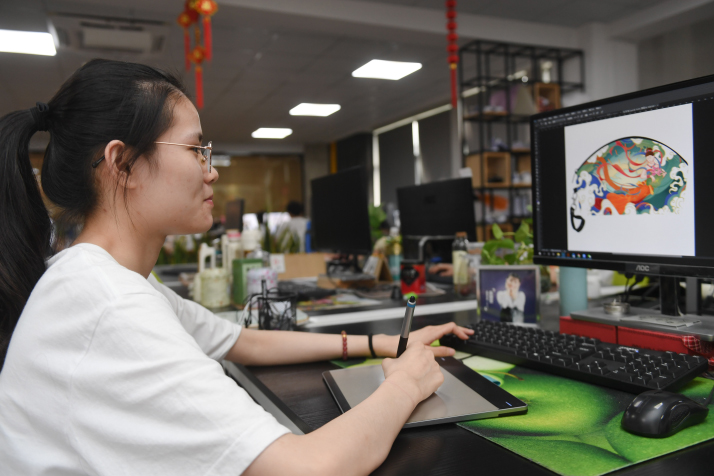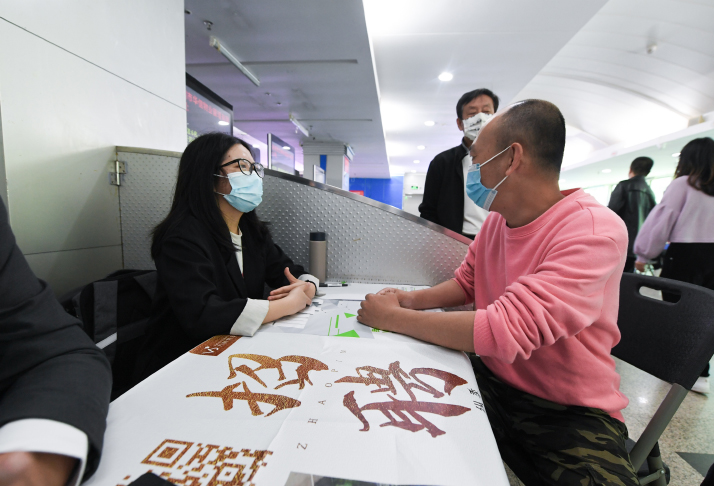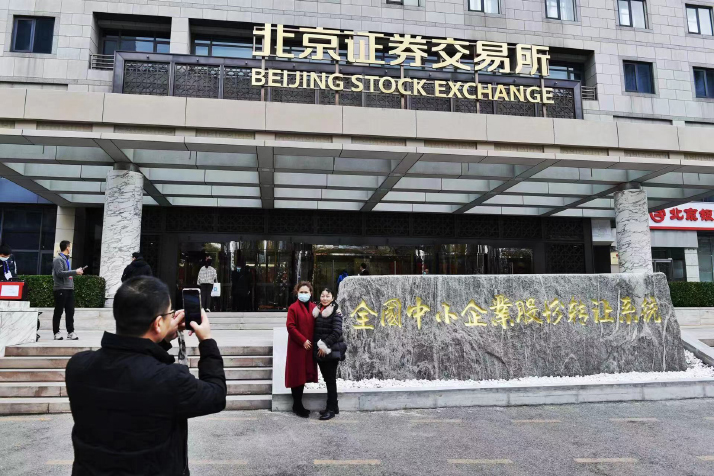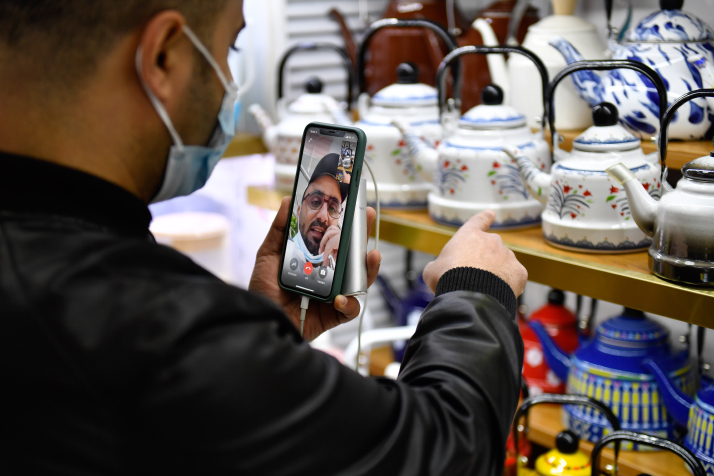| Economy |
| SMEs rise to challenges in a more conducive business environment | |
| Innovation-led and green development will be two key directions to promote the high-quality development of SMEs during the 14th Five-Year Plan (2021-25) period | |
|
|
 A designer creates the exterior of a cosmetics bag at a cross-border e-commerce startup in Quanzhou, Fujian Province, on July 14, 2020 (XINHUA)
On January 21, 10 days before the Spring Festival holiday (from January 31 to February 6 this year), the workshops of Baoji Saiwei, a heavy machinery manufacturer in Baoji, Shaanxi Province in northwest China, are in full swing to complete their orders. By late 2021, Saiwei had already received its orders for the first half of 2022. Deputy General Manager Li Hui told Beijing Review, "We need to deliver the products in time as well as explore new markets." That same day, in the capital of Beijing, Du Peifan, founder of ZhiqingFin, an artificial intelligence (AI) company focusing on smart speech services, is doing his routine work taking his employees through a checklist in service of their bank clients. The next day, on January 22, in Yiwu, known as the world's largest wholesale market of consumer goods in the eastern province of Zhejiang, Wei Lingying, CEO of OMAWine International, a company importing Spanish wines and foods, is busy talking to customers and delivering purchases. "We might need to work until the last day before the holiday," Wei struggled to squeeze in some time for this Beijing Review interview. Though operating in different sectors and playing individual roles in the market, all three are part of the most robust component of the Chinese economy—small and medium-sized enterprises (SMEs). The definition of an SME in China depends on the industry category and is based on the number of employees, annual revenue and total assets comprising a company. For example, a medium-sized industrial enterprise is defined as having up to 2,000 employees, while a small one less than 300. Most SMEs in China are privately held. SMEs, accounting for roughly 99 percent of all firms nationwide, are the main force behind China's economic and social development. According to a report released by the Ministry of Industry and Information Technology (MIIT) in 2020, over 50 percent of national tax revenue and 60 percent of GDP stem from SMEs. They create 70 percent of technological innovation and 80 percent of urban employment. In the face of challenges brought on by the COVID-19 epidemic, SMEs play a leading role in accelerating economic recovery and development. "It has been unanimously agreed upon in different countries that these companies can serve as an important engine to stimulate worldwide economic recovery," Liang Zhifeng, an official with the MIIT, said during an SME fair in Guangzhou, Guangdong Province, in September 2021. However, SMEs do face many difficulties in and concerns about further development. "The government should roll out more policies to support their development," Zhang Jianping, Deputy Director of the Academic Steering Committee with the Chinese Academy of International Trade and Economic Cooperation, said. "Meanwhile, SMEs also need to pursue new opportunities through their own efforts." Alive and kicking Sporadic COVID-19 cases, rising commodity prices, supply chain problems and financing difficulties, among others, pose treacherous challenges. The rising expenditures of importing wine and food products combined with a declining demand due to the pandemic put OMAWine International on edge. Compared to pre-pandemic times, wine orders decreased 20 percent during this year's pre-Spring Festival sales season, according to Wei. On the plus side, all three companies are still alive, inspiring those willing to have a go at entrepreneurship. They help advance the nationwide initiative spurring innovation to unleash market vitality and people's creativity. Saiwei only halted production for a brief period at the very onset of the COVID-19 epidemic in early 2020 and soon resumed operations. Nevertheless, the increase in raw material prices and the delays in logistics have made it difficult to control costs and deliver products on time; company leadership once even cut their own salaries to continue operations. "Like gears, we are the inseparable parts that guarantee the swift functioning of China's industrial and supply chains," Li said. "We, SMEs or private companies, could not simply give up and close up shop; we are not just enterprises, but also the economic backbone of our workers' families." Their being alive and kicking once again could not have happened without the government's support. Many businesses in Yiwu, mostly SMEs, already resumed operations in February 2020 as soon as local government agencies started arranging for charter flights and coaches to bring their workers back from other places as transportation was suffering epidemic disruptions. "Yiwu comes with a brilliant business environment; our will to survive is hard to overthrow," Wei said. The government has also ramped up measures, including tax breaks and financial support, to help SMEs weather out economic hardship. The newly added tax and fee cuts were expected to exceed 1 trillion yuan ($157 billion) in 2021, Wang Jun, head of the State Taxation Administration, said last December, adding that an estimated 200 billion yuan ($31.4 billion) of tax payments were deferred for micro, small and medium-sized enterprises (MSMEs) in the manufacturing sector during the year. In January, the Supreme People's Court issued directives on giving full play to judicial functions to help the development of MSMEs, including the creation of a green channel for these companies to settle debt disputes and banning arbitrary probes and shutdown of SMEs, which would allow firms involved to "take a breather" and give them a chance to turn their fortunes around.  A job fair for micro, small and medium-sized enterprises in Shenzhen, Guangdong Province, on February 24, 2021 (XINHUA)
In the face of trials SMEs usually gather in competitive industries, making it essential for them to adjust their business models and actively find new growth opportunities in the new market environment, Zhang said. He called for greater support from governmental departments and industrial organizations to help SMEs navigate their way through difficult times and boost the re-employment of laid-off workers. Compared with large intelligent speech companies that provide only one standard product, ZhiqingFin's customized services are better, especially in the post-sales field, according to Du. The pandemic has generally stimulated technological expansion, with AI now widely applied and competition rife within the industry. Yet financing remains an issue for SMEs. It's a tough task for Du to increase company bankrolling to invest in technology capacity and service research. "While the growth of our client number hasn't met expectations due to the epidemic and other factors, we could focus more on specialized services to deepen cooperation with financial institutions," Du said. "I remain confident as China's financial market bears solid development potential." Pan Gongsheng, Deputy Governor of the People's Bank of China, the central bank, said at a press conference in September 2021 that addressing the financing needs of SMEs is high on the agenda of the regulatory authority. Loans to micro and small firms totaled 17.8 trillion yuan ($2.75 trillion) as of late July 2021, up 29.3 percent year on year, according to Pan. The Beijing Stock Exchange (BSE), which started trading in November 2021, has pushed more innovation-driven SMEs into the capital market spotlight, easing their funding problems. According to BSE regulations, a company can refinance six months after going public, with a diversified issuance mechanism and financing tools on offer, such as common and preferred stocks as well as convertible bonds.  The Beijing Stock Exchange starts trading on November 15, 2021, focusing on funding for innovation-oriented small and medium-sized enterprises (WEI YAO)
Hi-tech SMEs like Saiwei also receive other financial assistance. As opposed to regular enterprises producing heavy machinery, Saiwei caters to specific customer requirements. Last year, it invested roughly 30 million yuan ($4.7 million) in research and development. "We sometimes provide our research and design blueprints in advance, which also need research spending, to win new contracts," Li said. The company now owns 40 patents. The company has been inducted into the Little Giant Firms program, covering small enterprises in their early stages of development, all focusing on high-end technologies. This could bring Saiwei millions of yuan in research support over the coming year. Du's company is also applying for the program. "Yet researchers are hard to cultivate. Baoji is not a big city, although we can provide a competitive salary, not too many young adults are willing to come here," Li said. "We are considering setting up research centers in big cities like Xi'an or Beijing to cooperate with our production base in Baoji," Li said. For Wei, she wants her brand to gain a larger following. "We attended different fairs to get to know new customers, but you can't just attend these once; you have to go every year. When visitors see you every year and know you are still 'alive,' they feel they can trust you," she explained. The Yiwu government actually covered 80 percent of the fair participation fee, according to Wei. Li and Du also put forward similar ideas. "We hope the government can help SMEs promote their brands, giving us the chance to attract more clients and recruit more skilled workers."  A Yemeni businessman selects teawares for a customer in Saudi Arabia through live-streaming from a consumer goods wholesale market in Yiwu, Zhejiang Province, on January 14 (XINHUA)
What's in store? Innovation-led and green development will be two key directions to promote the high-quality development of SMEs during the 14th Five-Year Plan (2021-25) period, according to a government guideline. The MIIT has set up a fund to support research and development projects of SMEs and launched several incentive policies to solve the problems for these businesses in terms of financing, talent cultivation, brand promotion and access to market information. "Meanwhile, we also need to pour more efforts into some labor-intensive industries considering regional industrial differences," Zhang said, suggesting the government help upgrade these SMEs via technology to help them become more sustainable. Finally, SMEs are encouraged to join forces and develop their business abroad. "The Regional Comprehensive Economic Partnership and other bilateral and multilateral free trade agreements provide a larger market space; Chinese SMEs should actively integrate themselves into regional and global value chains," Zhang concluded. (Print Edition Title: Firing Up the Growth Engines) Copyedited by Elsbeth van Paridon Comments to taoxing@cicgamericas.com |
|
||||||||||||||||||||||||||||||
|
